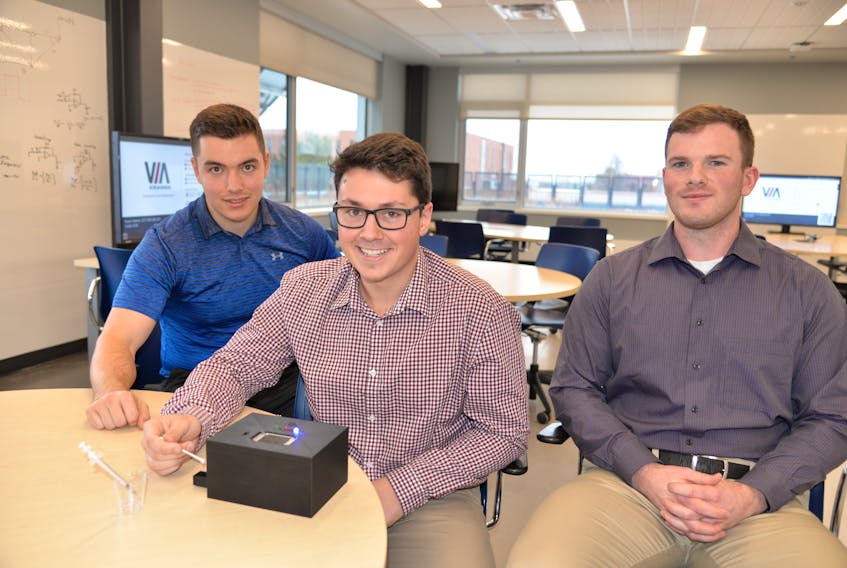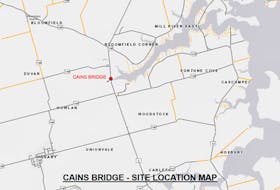CHARLOTTETOWN, P.E.I. - A group of UPEI engineering students has come up with a way to help detect levels of marijuana in drivers.
The students designed and developed a prototype, handheld THC detection device.
But before they consider taking the product or a technological aspect to market, they have some unfinished business to take care of.
“We’re going to concentrate on graduating first. And then after that, we’ll see what happens,” said Bryce Stewart of Wood Islands.
The group, comprised of Stewart, Mason Boertien of Souris and Robert Smith of Mount Stewart, presented their device as part of Ali Ahmadi’s fourth-year class on innovations in biomedical engineering in the School of Sustainable Design Engineering.
Other course presentations included improvements on existing technologies – an oyster heart monitor and a blood oximeter.
The group got the idea to develop a THC breathalyzer based on an alcohol breathalyzer presented in last year’s class.
“It is a different design that uses some of the same components that all breathalyzers would have to use. But, it is a different design,” said Stewart.
They also noted that with the impending legalization of marijuana, the device and technology are relevant.
RELATED: Ottawa proposing marijuana tax of at least $1 per gram, plus GST
The group tested the device with cotton swabs of THC and water and THC and saliva, as well as swabs with just water and saliva.
As one of the presenters joked, “our saliva should be THC free, but at the same time, everybody’s saliva is different.”
They tested the device, which is in a polycarbonate casing and slightly bigger than a Kleenex box, by placing a swab five millimetres from the gas sensor.
The sensor picks up the gas type and concentration and then produces a THC reading – a red light is positive and a green light is negative, explained Smith.
Ahmadi, the course instructor, came to UPEI from the University of British Columbia.
While a graduate student at UBC, he worked with a couple of his supervisors, who are also leading experts in developing handheld breathalyzers.
Along with his supervisors, Ahmadi was part of a group that worked with companies, such as Cannabix Technologies Inc., on developing the portable roadside technology.
Ahmadi recalled that some companies had roadside test devices so large they required a trailer to transport.
The federal government has recently proposed to set a blood drug concentration limit for THC for an impaired driving summary offence between two and five nanograms (ng) per millilitre of blood while above 5 ng would be either a summary or indictable consideration.
As well, it is proposed that when THC and alcohol are combined, a limit of more than 2.5 ng and 50 mg/ml be set.
By comparison, the blood alcohol concentration limit for an impaired driving offence is set at 80 milligrams (mg) of alcohol per 100 millilitres (ml) of blood.
Ahmadi suspects the product that does come to market will be similar to an alcohol pass/fail roadside test that indicates the level of THC presence for further testing.
Ahmadi would like to see the students try to take the product or part of its technology to market, especially since P.E.I. has a lot of support for startup companies.
In addition to police roadside testing, Ahmadi notes there are other applications for the students’ work on gas sensor technology, such as workplace testing for THC.
“The competition is, I think, to make these sensors more selective to THC and reducing the false responses. Whichever company gets there in terms of reliability to test results is going to play a more important role in the future,” he said.
With the existing device, the group has some improvements in mind, such as making it more compact and portable.
As well, one issue that came up with the presentation was that the device has trouble differentiating between alcohol (depending on the concentration) and THC.
As a result, they would like to introduce a filtering technique into the design to help with sorting out and identifying different gases.
“Just somehow eliminating the different gases and compounds, that would be a huge thing. We suggested microfluidic channels,” said Smith.
They are also mindful that it may not be prudent to take the device to market as a startup, especially since Cannabix is already in clinical trials for a device that could be used roadside by law enforcement.
“We deemed it almost nonviable to continue with our own business, at least a THC breathalyzer specifically. It’s kind of if we could develop our own technology and license it out,” said Smith.









